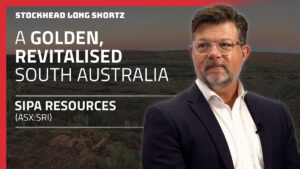In the world of gold, high grades do glitter brighter

Does high grade gold make you happier? It sure looks that way. Pic: pixelfit via Getty Images
When it comes to gold production, there are many companies that will insist that even low grade resources can be produced in an economical fashion.
And there’s plenty of evidence of that with Newcrest’s Boddington gold mine and Capricorn Metals’ (ASX:CMM) Karlawinda gold mine being noteworthy examples.
MineLife founding director Gavin Wendt told Stockhead that despite being a relatively low-grade operation by industry standards, Boddington has nevertheless operated successfully and profitably since 1987.
During 2022, Boddington produced 798,000oz at a grade of 0.801g/t at an operating cost of US$921 per ounce, together with 66,000,000 pounds of copper at a grade of 0.13%.
Meanwhile, the Karlawinda mine generated record annual gold production of 120,014oz at a grade of less than 1g/t and an all-in sustaining cost of just A$1,208 per ounce during 2023 financial year.
That being said, no company will ever say no to having a high-grade gold deposit.
“All things being equal, if two gold deposits had the same favourable geological conditions for commercial mining, then the higher grade gold deposit would be more profitable than the lower grade deposit,” Wendt explained.
“This is simply due to the fact that for the same mining and processing costs, more gold would be extracted from the same volume of rock in the case of the higher grade deposit, compared to the lower traded deposit.”
Black Cat Syndicate (ASX:BC8), which owns not one but two deposits that arguably have amongst the highest grade in Australia – Paulsens and Coyote – agreed with managing director Gareth Solly, saying that high-grade gold mines would typically require less upfront capital, less ore handling, and less processing overall, which in turn delivers higher margins.
“There is more than just grade that affects the economics of a deposit. The geometry of the deposit, the nature of the mineralisation and associated minerals also have an impact,” Solly pointed out.
“High-grade, high-recovery gold deposits with simple geometries typically have the best margins and Paulsens just happens to meet all those categories.”
High-grade for high-returns
To illustrate his point, Wendt brought up Agnico Eagle’s Fosterville mine in Victoria and Bellevue Gold’s (ASX:BGL) namesake project in Western Australia as examples.
“The Fosterville mine hosts proven mineral reserves of 453,000oz of gold (comprising 608,000t grading 23.19g/t gold), and in 2023 total cash costs are anticipated to be just US$457/oz on production of 305,000oz of gold,” he noted.
“The Bellevue gold mine is a potentially high-grade, high margin growth gold project, with a global mineral resource of 3.1Moz at 9.9g/t, and commercial production set to commence during Q4 2023 at a rate of 200,000ozpa at a AISC of A$1,000 to $1,100 per ounce.”
What’s immediately apparent is that both projects have better economics than their low-grade counterparts, which proves the points raised by both Wendth and Solly.
Following in the footsteps
Solly also likes to compare Black Cat’s efforts, which are aimed at bringing the Paulsens project back into production, with the likes of Northern Star Resources (ASX:NST) and Silver Lake Resources (ASX:SLR) when they first started out.
“I like to do comparisons back to those two companies because they both had high-grade gold deposits with small resources, established infrastructure, small targets for production and small mine lives,” he explained.
“They were successful in starting those operations up again and produced lots of high grade gold and successfully increasing their market caps.
“I think, those starter operations for those deposits are a great analogy and comparison to what we are doing at Paulsens right now because it is the same deposit that Northern Star started with the same opportunities whilst having the same management team that start Silver Lake.”
Black Cat has been going great guns with Paulsens, which it has been drilling for just seven months and has already increased resources by 3.7 times to 328,000oz grading 9.9g/t gold.
“We have a new mine plan that we have been adding about 12,000oz to for every month we drill, which is adding a lot of resources to a mine that has been on care and maintenance for a while, and we have vision of addition growth,” Solly added.
“We have discovered the Paulsens main zone extension at depths that has the potential to increase mine life and cashflow as well as the likes of Paulsens Repeat – the repetition of the same style system that is immediately adjacent and parallel.
“We also have the Paulsens East trend, which needs more work, and there’s lot of extensional drilling still going into the Gabbro Veins and other parts of the mine.
“Also in the region, we have Belvedere, Mt Clement, and a number of other targets that already have resources as well as a whole heap of prospects that need drilling for the very first time.”
Solly also noted that while high-grade underground gold mines in Australia typically didn’t have very long mine lives, the fact that Black Cat already had a three-year plan squared away for Paulsens was a fantastic start.
“It does give us confidence because normally as long as you continue to drill, you can continue to replace what you produce and grow your mine life, so we are very confident we can do that and we are looking forward to getting that started,” he added.
Paulsens may be the focus of Black Cat’s efforts to achieve gold production and cashflow, but it is worth noting at this point that its Coyote project has an even higher grade (and larger) resource of 356,000oz at 14.6g/t gold which was only passed over due to Paulsens being at a more advanced stage.
The company’s lead project has both established infrastructure and a long operating history that drastically lowers the restart risk.
Additionally, the mine is expected to return to production within 26 weeks – a process that will require the company to upgrade the electrical system, power station, crusher and CIL tanks whilst building a 20,000t stockpile eight weeks prior to commissioning.
Not the only high-grade resource on the prowl
While high-grade gold projects held by small-cap companies like Black Cat are comparatively rare, that’s not to say that they don’t exist. Here are a number of examples.
Challenger Gold (ASX:CEL)
While Challenger’s 2.8Moz Hualilan project in Argentina isn’t technically a high-grade resource, it does host a high-grade core of 1.6Moz at 5g/t gold equivalent.
And it is this high grade core that is the focus of the Scoping Study that is currently underway to deliver a low-capex, low-cost project.
More recently, metallurgical testing assessing a carbon-in-pulp or carbon-in-leach processing routes successfully resulted in 89% recovery for gold, which has the potential to lower Capex compared to using flotation for gold recovery.
Carawine Resources (ASX:CWX)
Carawine’s Tropicana North project in Western Australia’s northeastern Goldfields region has a resource of 463,000t grading 4.8g/t, or 71,000oz of contained gold.
Notably, this has a higher confidence Indicated component totalling 93,000t at 5.1g/t gold, or 15,000oz of contained gold.
Gascoyne Resources (ASX:GCY)
At 721,000z grading 5.85g/t gold, Gascoyne’s Never Never deposit in Western Australia’s Goldfields region is central to its plans to restart its mothballed 2.5Mtpa Dalgaranga mill and achieve economical gold production, something which eluded past iterations of the company.
Its discovery within the Gilbey greenstone belt had quickly led first to an initial resource of 303,000oz at 4.64g/t gold before growing to the current level.
That Never Never was delineated at a low cost of just $13/oz and has an underground component averaging 1,590 ounces per vertical metre over a short strike length with favourable geometry – well past the 1,000oz per vertical metre which is generally seen as a strong benchmark for underground mines – just adds to its attractiveness.
Matsa Resources (ASX:MAT)
While Matsa’s Lake Carey project is currently subject to an agreement giving AngloGold Ashanti three months (since the end of July) to conduct due diligence and to discuss and negotiate a potential transaction, it does host a high-grade component to its resource.
The Red October underground deposit has a resource of 1.35Mt grading 5.6g/t gold, or about 244,000oz of contained precious metal, a significant component of the overall 936,000oz resource.
AngloGold Ashanti paid the company $500,000 for the maintenance and de-watering costs for the Red October mine while it assesses the individual projects and the greater Lake Carey project.
Vertex Minerals (ASX:VTX)
Vertex is one of the rare companies with a higher grade resource than Black Cat’s Paulsen resource.
Following a recent upgrade, its Reward underground gold mine in New South Wales now has a resource of 419,000t grading 16.72g/t, or 225,200oz of contained gold. This includes a higher confidence Indicated Resource of 141,000t at 15.54g/t, or 70,500oz of contained gold.
The underground mine access point is immediately adjacent to the Hill End gold plant, which is currently undergoing wet commissioning.
Stage 1 production will use adjacent stockpiles to feed the plant while Stage 2 will use high-grade ore from Reward.
At Stockhead we tell it like it is. While Black Cat Syndicate, Challenger Gold, Carawine Resources, Gascoyne Resources, Matsa Resources and Vertex Minerals are Stockhead advertisers, they did not sponsor this article.
Related Topics

UNLOCK INSIGHTS
Discover the untold stories of emerging ASX stocks.
Daily news and expert analysis, it's free to subscribe.
By proceeding, you confirm you understand that we handle personal information in accordance with our Privacy Policy.








